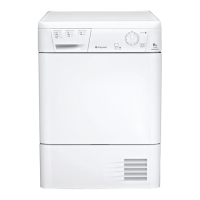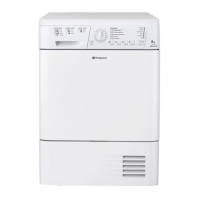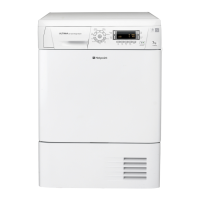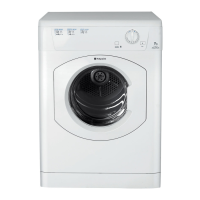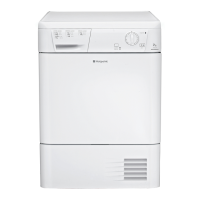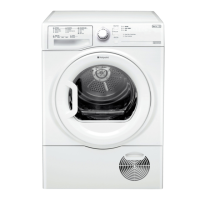Do you have a question about the Hotpoint Tumble Dryer and is the answer not in the manual?
Information on voltage, current requirements, and the fitted plug.
Procedure for replacing the fuse in the plug.
Guidance on moulded plug safety and replacing the plug.
Instructions for replacing the mains cable by a qualified electrician.
Identifies the location of the model and serial numbers on the dryer.
Locates the fluff filter and reminds users to clean it after each use.
Indicates the position of the appliance's rating plate.
Identifies the main drum and the air intake grille for ventilation.
Shows where the vent hose is fitted for rear venting.
Advises on suitable locations, avoiding heat sources and ensuring clearance.
Instructions for stacking the dryer on a washing machine, including stacking kits.
Emphasizes the need for adequate room ventilation for safe operation.
Details on fitting the vent hose for mobile venting and ensuring it's not squashed.
Details on permanent venting solutions using wall or window kits.
Specific fitting instructions for wall and window venting setups.
Explains how to open the dryer door and its effect on the programme.
Details on load limits for natural and man-made fibres.
Provides weights of common clothing items for estimating loads.
Explains common symbols indicating if items can be tumble dried.
Lists materials and items that should not be put in the dryer due to safety risks.
Drying requirements for blankets and bedspreads, especially acrylics.
Advice on drying permanently pleated, creased, or starched items.
Recommendation for using liquid fabric conditioner in the wash, not the dryer.
Information on cleaning garments using Home Dry Cleaning Kits.
Explains the filter's role in trapping lint and the consequences of it being blocked.
Step-by-step guide on how to remove, clean, and replace the fluff filter.
Explains the function of the heat switch for low and high heat settings.
Details on setting the drying time using the timer knob.
Description of the final cooling phase and its importance.
Instructions on setting the drying time using the timer control.
Explains how to select between low and high heat settings.
Details the final cooling phase and why it should be completed.
Guide on using the delay timer to set a delayed start for the drying programme.
Instructions for setting programmes and selecting options like Automatic Drying.
Explanation of automatic drying for average and large loads, including heat selection.
Details the short conditioning programme for previously dried clothes.
Instructions for using the timed drying function for specific loads.
Explains the final cooling phase and how to manage it.
Describes the function of Auto dry light, drying light, and the buzzer alarm.
Lists factors influencing drying duration, such as fabric type and load size.
Provides approximate drying times for different fabrics, loads, and heat settings.
Advises against overdrying to maintain fabric softness and reduce wrinkling.
Explains the programme's function to condition, not dry, garments.
Key advice on material suitability and achieving best results with the programme.
Specifies maximum load weights for different materials for the Easy Iron programme.
Steps to take after finishing a drying cycle, including switching off.
Guidance on cleaning the filter, drum, exterior, and venting components.
Information on lubrication requirements and prohibited cleaning agents.
Basic troubleshooting steps for common problems like 'it won't start'.
Checks for slow drying or poor performance, including filter and vent checks.
Specific checks for issues with automatic drying programmes.
Instructions on what information to provide when contacting the service office.
Advice on using genuine spare parts and avoiding DIY repairs.
Safety guidelines for disposing of the appliance, including removing plugs and doors.
Contact details and required information for repair services.
Information on joining extended warranty and ordering spare parts.
Contact number for further product information.
Information on voltage, current requirements, and the fitted plug.
Procedure for replacing the fuse in the plug.
Guidance on moulded plug safety and replacing the plug.
Instructions for replacing the mains cable by a qualified electrician.
Identifies the location of the model and serial numbers on the dryer.
Locates the fluff filter and reminds users to clean it after each use.
Indicates the position of the appliance's rating plate.
Identifies the main drum and the air intake grille for ventilation.
Shows where the vent hose is fitted for rear venting.
Advises on suitable locations, avoiding heat sources and ensuring clearance.
Instructions for stacking the dryer on a washing machine, including stacking kits.
Emphasizes the need for adequate room ventilation for safe operation.
Details on fitting the vent hose for mobile venting and ensuring it's not squashed.
Details on permanent venting solutions using wall or window kits.
Specific fitting instructions for wall and window venting setups.
Explains how to open the dryer door and its effect on the programme.
Details on load limits for natural and man-made fibres.
Provides weights of common clothing items for estimating loads.
Explains common symbols indicating if items can be tumble dried.
Lists materials and items that should not be put in the dryer due to safety risks.
Drying requirements for blankets and bedspreads, especially acrylics.
Advice on drying permanently pleated, creased, or starched items.
Recommendation for using liquid fabric conditioner in the wash, not the dryer.
Information on cleaning garments using Home Dry Cleaning Kits.
Explains the filter's role in trapping lint and the consequences of it being blocked.
Step-by-step guide on how to remove, clean, and replace the fluff filter.
Explains the function of the heat switch for low and high heat settings.
Details on setting the drying time using the timer knob.
Description of the final cooling phase and its importance.
Instructions on setting the drying time using the timer control.
Explains how to select between low and high heat settings.
Details the final cooling phase and why it should be completed.
Guide on using the delay timer to set a delayed start for the drying programme.
Instructions for setting programmes and selecting options like Automatic Drying.
Explanation of automatic drying for average and large loads, including heat selection.
Details the short conditioning programme for previously dried clothes.
Instructions for using the timed drying function for specific loads.
Explains the final cooling phase and how to manage it.
Describes the function of Auto dry light, drying light, and the buzzer alarm.
Lists factors influencing drying duration, such as fabric type and load size.
Provides approximate drying times for different fabrics, loads, and heat settings.
Advises against overdrying to maintain fabric softness and reduce wrinkling.
Explains the programme's function to condition, not dry, garments.
Key advice on material suitability and achieving best results with the programme.
Specifies maximum load weights for different materials for the Easy Iron programme.
Steps to take after finishing a drying cycle, including switching off.
Guidance on cleaning the filter, drum, exterior, and venting components.
Information on lubrication requirements and prohibited cleaning agents.
Basic troubleshooting steps for common problems like 'it won't start'.
Checks for slow drying or poor performance, including filter and vent checks.
Specific checks for issues with automatic drying programmes.
Instructions on what information to provide when contacting the service office.
Advice on using genuine spare parts and avoiding DIY repairs.
Safety guidelines for disposing of the appliance, including removing plugs and doors.
Contact details and required information for repair services.
Information on joining extended warranty and ordering spare parts.
Contact number for further product information.



